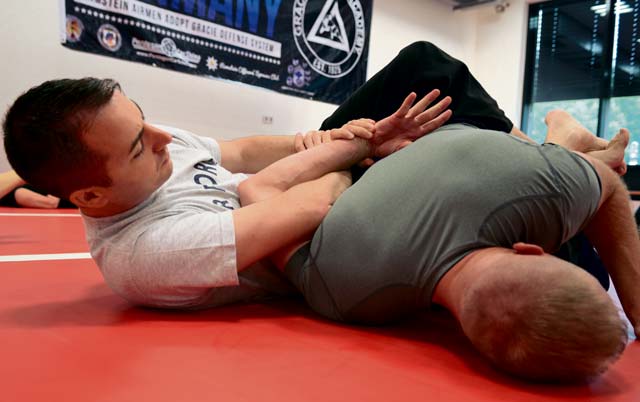
Walking down a street alone, you receive a text message. While responding, you don’t notice the person quickly approaching from behind. By the time you do, it’s too late. The person moves to strike. What do you do?
More than 100 members from the KMC and other U.S. military bases in Europe not only got the chance to learn what to do in a similar situation, but also how to teach others what to do after taking the Gracie Defense Systems seminar Sept. 1 to 5 on Ramstein.
Gracie Defense Systems is a five-day instructor certification course that teaches modified Jiu-Jitsu techniques emphasizing the use of leverage and timing over strength and speed to make them more accessible to smaller framed individuals. Techniques range from preemptive boundary setting to physical self-defense designed to neutralize an aggressor.
“It’s important to approach any problem from multiple directions,” said Gracie Defense Systems instructor Eve Gracie. “This is just one of those options — (another) tool to add to the toolbox.”
During the seminar, the participants learned different strategies to be more aware of their surroundings, recognize warning signs and escape potentially dangerous situations.
“I had no idea what to expect coming in,” said student Kelly Bellew. “It’s totally amazing to me, because I’m not fitness oriented. I don’t go to the gym. I’m not strong, but this is the first time someone has shown me that you don’t need strength and moves to defend against a man that may overpower me. I can use my leverage. It’s just giving you the tools that you may need to get out of any situation.”
The participants in this seminar will have 90 days to train and practice the techniques. In that time, they will be required to send videos to the Gracie Jiu-Jitsu Academy showing themselves performing the techniques. If their proficiency is deemed adequate, they will be fully certified to teach.
“I like teaching, and I like martial arts,” said Senior Airman David Stout, 1st Air and Space Communications Operations Squadron. “I think this is a great volunteer opportunity for me, something that I can get really passionate about and really enjoy doing.”
Though physical techniques are the first thing students are taught, the instructors will also teach verbal and psychological techniques.
“We firmly believe that physical self-defense is only a means for delivering the verbal… and the psychological self-defense,” Gracie said. “We feel like you have to understand all three components.”
The techniques are designed to not only neutralize a situation, but to also do it without escalating an incident and helping the students remain in or regain control. Physical techniques ranged from blocking strikes to disarming an assailant, in both standing and ground situations.
“I’ve only been practicing martial arts for the last three years or so,” Stout said. “It’s something that I found I really enjoy doing. It’s a great way to gain confidence. That’s not to say you should go around picking fights, but if you are ever put in a situation where you might be compromised, you can more than likely walk out of it. To be able to take that and give that same feeling to people is something I feel strongly about.”
The classes are held on a weekly basis. Additionally, units or private organizations are able to request instructors to conduct training. Instructors will teach each class to the lowest knowledge base of the newest student. This allows anyone to join a class at any time, while also giving more proficient students a chance to become more skilled in a technique they already know.
The classes are free to any person in possession of a valid Department of Defense ID card who has access to the base where the instructors will be teaching the class.
For more information, contact Master Sgt. Mark Tilsher, KMC Gracie Defense Systems director, at kmc.gds@us.af.mil.


